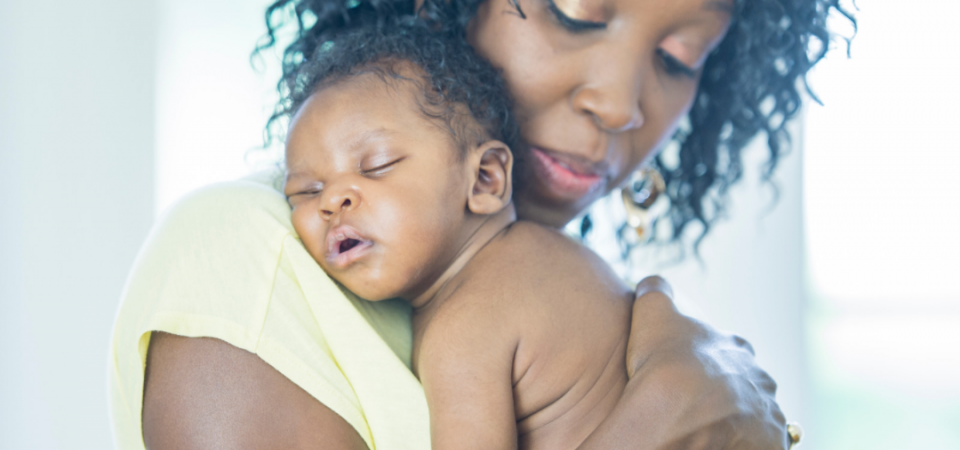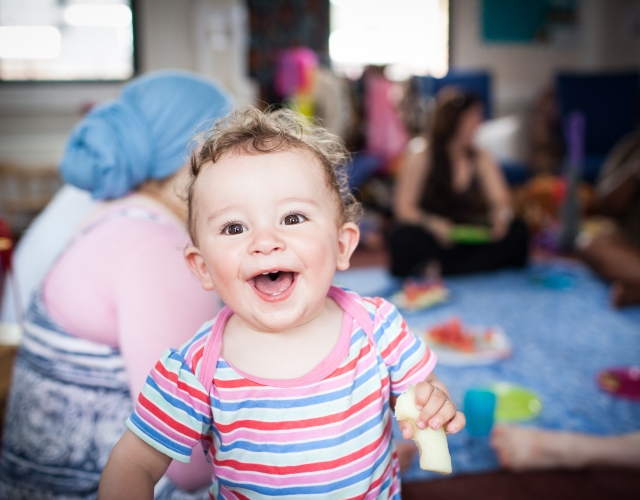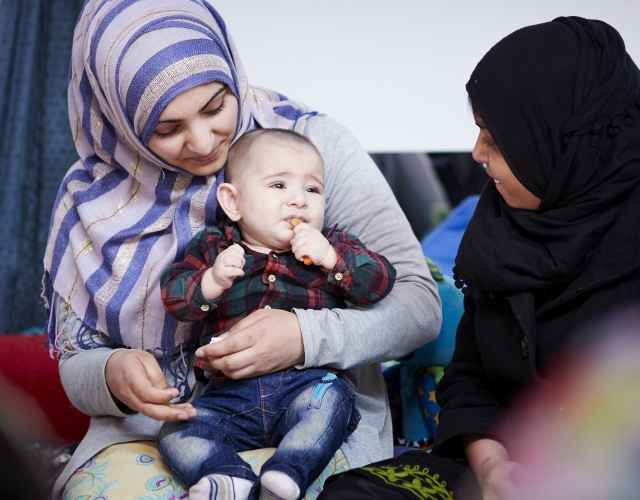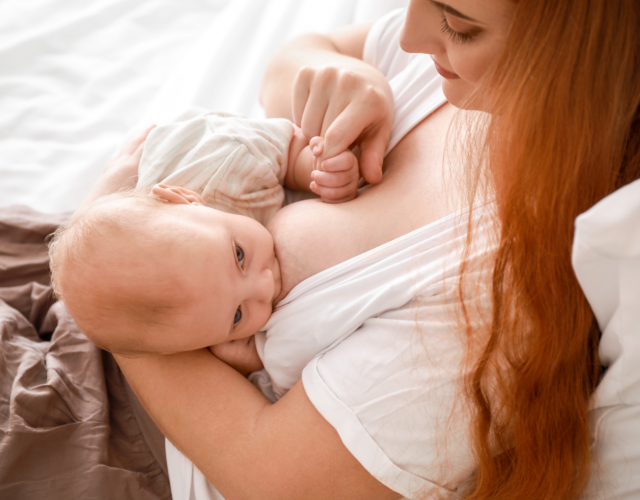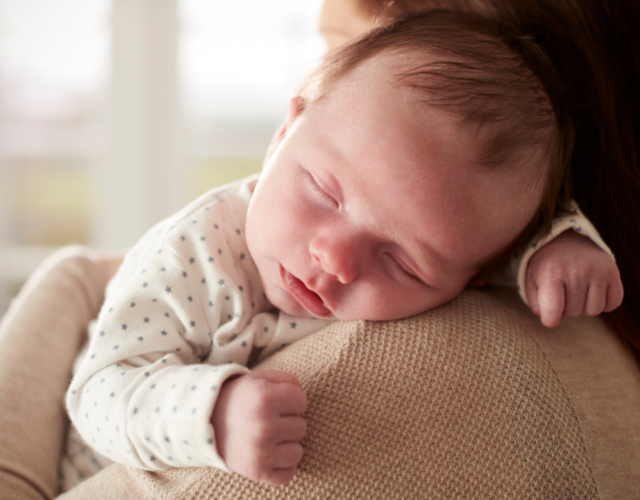Top tips for feeding your baby
Feed your baby when they show signs of being hungry (moving head and mouth around, sucking on fingers).
- Make sure that you are sitting comfortably. Always hold your baby close to you and look into their eyes when feeding. This helps the baby feel safe and loved.
- Hold your baby fairly upright for feeds (rather than lying down), with their head supported so that they can breathe and swallow comfortably. Try and alternate the side you hold your baby.
- Brush the teat against your baby’s lips and, when your baby opens their mouth wide, allow them to draw in the teat.
- Keep the bottle in a horizontal position (just slightly tipped) to stop milk from flowing too fast.
- If the teat becomes flattened while you are feeding, pull gently on the corner of your baby’s mouth to release the vacuum.
- Your baby may need short breaks during the feed and may need to burp sometimes. When your baby does not want any more feed, hold them upright and gently rub or pat their back to bring up any wind.
- Watch for signs that your baby has had enough: turning away, spitting out the teat, dribbling milk, stopping sucking. If your baby is showing signs of fullness, gently remove the teat or bring the bottle downwards to cut off the flow of milk. Stop feeding even if there is still milk in the bottle.
Never leave your baby alone with a bottle as there is a risk they might choke. Don’t ‘prop’ the bottle to keep milk flowing.
Safe milk preparation
A step-by-step guide to preparing a formula feed:
Step 1: Fill the kettle with at least 1 litre of fresh tap water (do not use water that has been boiled before).
Step 2: Boil the water. Then leave the water to cool for no more than 30 minutes, so that it remains at a temperature of at least 70C.
Step 3: Clean and disinfect the surface you are going to use.
Step 4: It's important that you wash your hands.
Step 5: If you’re using a cold-water steriliser, shake off any excess solution from the bottle and the teat, or rinse them with cooled boiled water from the kettle (not tap water).
Step 6: Stand the bottle on the cleaned, disinfected surface.
Step 7: Follow the manufacturer's instructions and pour the amount of water you need into the bottle. Double-check that the water level is correct. Always put the water in the bottle first, while it’s still hot, before adding the powdered formula.
Step 8: Loosely fill the scoop with formula powder, according to the manufacturer's instructions, then level it using either the flat edge of a clean, dry knife or the leveller provided. Different tins of formula come with different scoops. Make sure you only use the scoop that comes with the formula
Step 9: Holding the edge of the teat, put it into the retaining ring, check it is secure, then screw the ring onto the bottle.
Step 10: Cover the teat with the cap and shake the bottle until the powder is dissolved.
Step 11: It's important to cool the formula so it's not too hot to drink. Do this by holding the bottle (with the lid on) under cold running water.
Step 12: Test the temperature of the formula on the inside of your wrist before giving it to your baby. It should be body temperature, which means it should feel warm or cool, but not hot.
Step 13: If there’s any made-up formula left in the bottle after a feed, throw it away.
Sterilising your baby's bottles
It's important to sterilise all your baby's feeding equipment, including bottles and teats until they are at least 12 months old. This applies to equipment for both formula milk and expressed breast milk.
This will protect your baby against infections, in particular diarrhoea and vomiting.
Before sterilising, you need to:
- Clean bottles, teats and other feeding equipment in hot, soapy water as soon as possible after feeds.
- Use a clean bottle brush to clean bottles (only use this brush for cleaning bottles), and a small teat brush to clean the inside of teats. You can also turn teats inside out then wash them in hot soapy water. Do not use salt to clean teats, as this can be dangerous for your baby.
- You can put your baby's feeding equipment in the dishwasher to clean it if you prefer. Putting feeding equipment through the dishwasher will clean it but it does not sterilise it. Make sure bottles, lids and teats are facing downwards. You may prefer to wash teats separately by hand to make sure they are completely clean.
- Rinse all your equipment in clean, cold running water before sterilising.
How to sterilise baby feeding equipment
There are several ways you can sterilise your baby's feeding equipment. These include:
Coldwater sterilising solution
Follow the manufacturer's instructions.
Leave feeding equipment in the sterilising solution for at least 30 minutes.
Change the sterilising solution every 24 hours.
Make sure there are no air bubbles trapped in the bottles or teats when putting them in the sterilising solution.
Your steriliser should have a floating cover or a plunger to keep all the equipment under the solution
Steam sterilising (electric steriliser or microwave)
It's important to follow the manufacturer's instructions, as there are several different types of sterilisers.
Make sure the openings of the bottles and teats are facing downwards in the steriliser.
Manufacturers will give guidelines on how long you can leave equipment in the steriliser before it needs to be sterilised again.
Sterilising by boiling
Make sure the items you want to sterilise in this way are safe to boil.
Boil the feeding equipment in a large pan of water for at least 10 minutes, making sure it all stays under the surface.
Set a timer so you do not forget to turn the heat off.
Remember that teats tend to get damaged faster with this method. Regularly check that teats and bottles are not torn, cracked or damaged.
After you've finished sterilising
- It's best to leave bottles and teats in the steriliser or pan until you need them.
- If you do take them out, put the teats and lids on the bottles straightaway.
- Wash and dry your hands before handling sterilised equipment. Better still, use some sterile tongs.
- Assemble the bottles on a clean, disinfected surface or the upturned lid of the steriliser.
Formula milks
Most infant formula is made from cow’s milk that has been treated to make it suitable for babies, and it is the only infant formula your baby needs. Infant formula is available in two forms:
- Ready-to-feed liquid infant formula, sold in cartons, which is sterile
- Powdered infant formula, which is not sterile.
First infant formula is suitable for newborns and should be the first formula you give to your baby. Your baby can stay on this formula when you start to introduce solid foods at around six months and continue on it throughout the first year. When your baby is one year old, they can start to drink whole cow’s milk.
‘Hungry baby milks’ or ‘second milks’ contain more of a protein called casein than first infant formula and this is thought to make your baby feel more full. However, there is no evidence that babies settle better or sleep longer when fed this formula.
Some milks are labelled as being suitable for babies aged six months and over, such as ‘follow-on milk’, ‘toddler milk’ and ‘growing up milk’. They should never be fed to babies under six months old and there is no need to switch to these milks after six months - first infant formula is the only type of formula your baby needs until they can have full fat cow’s milk at a year old.
Like powdered infant formula, follow-on formula is not sterile and will need careful preparation.
Some follow-on formula has cereal added to it, and is described as a ‘night-time feed for babies’. This type of formula is not necessary and there is no evidence that babies settle better or sleep longer when fed this. It should never be given to babies under six months.
If you think a particular brand of infant formula disagrees with your baby, ask your GP, midwife or health visitor for advice.
If you think your baby might be allergic to cow’s-milk-based formula, talk to your GP. They can prescribe special formula feeds for babies with cow’s milk allergy. Some formulas in the shops are labelled as being ‘hypoallergenic’ but they are not suitable for babies diagnosed with a cow’s milk allergy.
Not all milk is suitable for feeding babies. Here are some of the types of milk you should never give to a baby under one year:
- Goat’s milk
- Sheep’s milk
- Soya milk (unless your midwife, health visitor or GP advises otherwise)
- Other types of drinks known as ‘milks’ such as rice, oat or almond drinks
- Dried milk
- Evaporated milk
- Condensed milk.
Cow’s milk should not be given as a main drink to infants under one year, but it’s okay to use small amounts of pasteurised whole cow’s milk when cooking and preparing foods for your baby from six months onwards. Other full-fat dairy products such as yoghurt or fromage frais can be given after six months, once your baby is used to eating solid foods.
Frequently Asked Questions
My baby doesn’t finish the whole bottle, can they finish it later?
It’s important to never reuse any unused formula or breastmilk, so throw it away when the feed’s finished. Feed warmed formula to your baby right away - don't heat it in advance, because bacteria can grow very quickly in warm liquid. If your baby starts a bottle of formula but doesn't finish it within an hour, throw it away. Don't refrigerate and reheat leftovers. Bacteria from your baby’s mouth could seep into the bottle, contaminate the formula, and make your baby sick.
If I’m busy can my baby feed itself?
When you are bottle-feeding your baby never leave your baby alone to feed with a propped-up bottle as they may choke on the milk, so stay with them and enjoy that special cuddle.
My baby seems ill after having formula
If you think your baby might be allergic to, or intolerant of, formula talk to your GP. If necessary, they can prescribe a special formula feed. Some formula is labelled as hypoallergenic, but this isn't suitable for babies with a diagnosed cows' milk allergy. Soya formula should only be given to babies under medical supervision.
Always talk to your GP before using hypoallergenic or soya-based formula.
Feeding out and about
Formula feeding away from home
Make up each feed as your baby needs it. Use boiled water at a temperature of 70˚C or above to reduce the risk of infection. Water at this temperature will kill any harmful bacteria that may be present. Remember to let the feed cool before you give it to your baby.
When feeding your baby away from home, you can use ready-to-feed infant formula milk with an empty sterilised feeding bottle. If you are using powdered infant formula, this is the safest way to make up a feed to take with you.
You will need:
- A correctly measured amount of infant formula powder (for one feed) in a small clean and dry container.
- A vacuum flask of hot water that has just been boiled.
- An empty sterilised feeding bottle with cap and retaining ring in place, which can be removed when you are ready to make up the feed.
Make up a fresh feed only when your baby needs it.
Remember to:
- Follow the instructions on the powdered formula for the correct quantities of powder and water.
- Make sure the water is still hot when you come to use it, otherwise any bacteria in the infant formula may not be destroyed.
- Put the hot water in the bottle first, taking care to measure it correctly. Then add the powder and shake the bottle to dissolve it.
- Cool the feed before giving it to your baby by holding the bottom half of the bottle under cold running water. Move the bottle about under the tap to ensure even cooling. Make sure that the water does not touch the cap covering the teat. Check the temperature on your own wrist.
- The vacuum flask does not need to be sterilised but should be clean and only used for your baby. The boiling water should kill any bacteria present in the flask. If the flask is full and securely sealed, the water will stay above 70˚C for several hours.
Transporting a feed
If it is not possible to make up a fresh feed by following the advice above or if you need to transport a feed – for example to a nursery or childminder – you should prepare the feed at home and cool it, for at least one hour, at the back of the fridge.
Remember to make up a feed only when your baby needs it.
Take it out of the fridge just before you leave and carry it in a cool bag with an ice pack. If made-up formula is stored:
- At room temperature: use within 2 hours.
- In a cool bag with an ice pack: use within 4 hours.
- Stored in a fridge: use within 24 hours.
Warming a feed
When you are ready to use the feed, place the bottle in a container of warm water to heat it up. Always test the feed on the inside of your wrist to make sure if it isn’t too hot before you give it to your baby. Never use a microwave to heat chilled infant formula as there is a danger of overheating the formula. It can also heat the milk unevenly (causing ‘hot spots’) and could scald your baby’s mouth. Throw away any milk left in the bottle after a feed.

